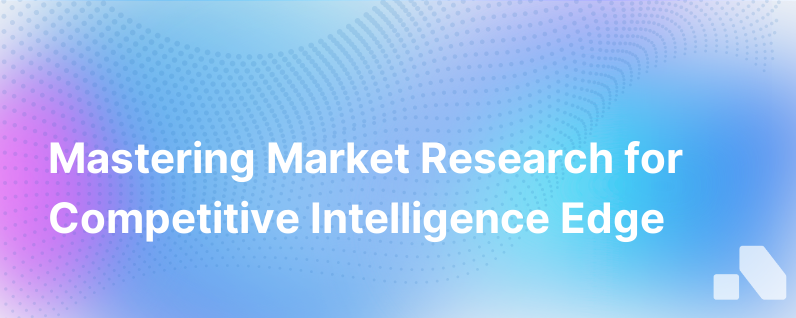Competitive Intelligence Market Research
Published on November 10, 2023 by David Zhang
In the complex and highly competitive business world, gaining an edge over competitors requires more than just a quality product. Successful companies need insights into their competition's strategies and tactics to stay ahead. This advantage comes in the form of competitive intelligence - an essential part of market research.
But what exactly is competitive intelligence? And how can you conduct competitive intelligence market research effectively? In this article, we will explore these aspects and more.
Understanding Competitive Intelligence
Competitive intelligence is the process of collecting, analyzing, and applying information about competitors, market trends, and consumers. It includes gathering data from a range of sources including financial reports, social media, customer reviews, and competitors' websites.
The goal isn't to spy on competitors, but to use the acquired data to make informed business decisions. By understanding your competitors and the market, you can anticipate challenges and capitalize on opportunities before others do.
Why Competitive Intelligence is Crucial
It's not enough to have an innovative product. Businesses must also navigate the market context within which they operate. Competitive intelligence aids in this in three key ways:
- Risk Mitigation: By providing insights into rivals' strategies, competitive intelligence helps businesses anticipate competitors' actions and devise proactive strategies.
- Improved Decision-Making: The data collected provides essential insights into market trends and consumer preferences. This supports evidence-based decision making.
- Strategic Advantage: Armed with intelligence on competitors' strengths and weaknesses, businesses can reinforce their unique selling propositions and exploit competitors' vulnerabilities.
How to Conduct Competitive Intelligence
There are many ways to collect competitive intelligence, but it primarily involves systematic collection, analysis, and interpretation of data. Here’s a step-by-step guide on how to do it:
-
Identify the Objectives: Reflect on what you are looking to achieve through your competitive intelligence analysis. This could include identifying market trends, exploring competitor strengths or vulnerabilities, or uncovering untapped market opportunities.
-
Define Your Competitors: Identify your key competitors. There are two types - direct and indirect. Direct competitors sell a product or service that's similar to yours and satisfies the same customer need. Indirect competitors might sell a different product or service, but they compete for the same customer dollar.
-
Data Collection: Now you're ready to start collecting data. Use a variety of sources, such as industry reports, financial filings, social media analyses, customer reviews, patent filings, competitor websites and job postings. Remember, the more diverse the sources, the more balanced and trustworthy your insights will be.
-
Data Analysis: After collecting the data, you must analyze it to identify trends, uncover insights and develop hypotheses. Look beyond the obvious - things that are hidden can often yield the most important insights.
-
Intelligence Application: Translate your findings into tangible actions. Perhaps you learned that a competitor is struggling with customer service, opening up an advantage for you to exploit by emphasizing your own outstanding customer service.
-
Continuous Monitoring: Competitive intelligence is not a one-time project. It's a continuous process that needs to be integrated into your business strategy. Regular updates will keep you abreast of any changes in the competitive landscape.
Competitive Intelligence for B2B Sales
In B2B sales, competitive intelligence can unlock a new layer of strategic selling. Representative uses include:
- Prospecting: By understanding your competitor's target demographic, you can refine your own target audience which can greatly improve lead generation.
- Sales Battlecards: Sales battlecards are a useful resource, providing reps with quick insights about competitors to use in sales battles. They typically include information about the competitor's product, pricing, strengths, and weaknesses.
- Product Development: Understanding the features and benefits touted by competitors can guide your product development efforts ensuring your product remains competitive, or even superior.
For B2B sales teams, an ideal solution is an AI-driven competitive intelligence platform like Aomni. Saying goodbye to the manual, exhaustive data mining process, Aomni's AI scans the market in real-time, delivering the much-needed edge in today's data-driven sales world.
Conclusion
In the fast-paced business environment, staying ahead of the competition is critical to success. Competitive intelligence provides the insights necessary to navigate the market landscape, enabling businesses to make informed strategic decisions that drive growth. With AI-powered platforms like Aomni, gathering this intelligence has never been easier.